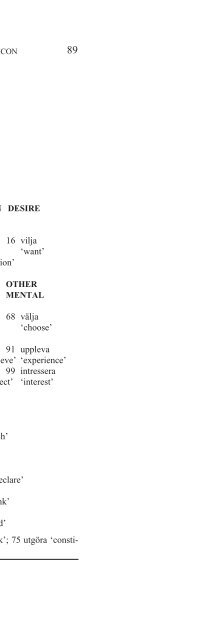Cognitive Semantics : Meaning and Cognition
Cognitive Semantics : Meaning and Cognition
Cognitive Semantics : Meaning and Cognition
Create successful ePaper yourself
Turn your PDF publications into a flip-book with our unique Google optimized e-Paper software.
188 JORDAN ZLATEV<br />
respond by giving the red car, in analogy to the red ball <strong>and</strong> the blue car. But,<br />
then again, the child may make a mistake, <strong>and</strong> the parent will have to correct<br />
it: “No, not the blue car, the red car” — <strong>and</strong> the process of training will<br />
continue. Once the child has mastered the distinctions in this game, it can<br />
generalize <strong>and</strong> use this ability in other games: it will be able to draw red suns<br />
<strong>and</strong> blue moons, but not because it has formed some “context-independent”<br />
concept of REDNESS, but because new uses constantly draw on old ones, in the<br />
accumulative ability to use language appropriately in ever new contexts.<br />
A number of experiments with the extended version of Regier’s system<br />
(cf. Figure 4) were performed in order to lend some empirical support for this<br />
view <strong>and</strong> against Chomsky’s “anti-generalization” position. The system was<br />
trained on some, but not all verb-preposition pairs, e.g., on the pairs “be<br />
over”, “be under”, “go over”, “go under” <strong>and</strong> “fly over”, but not on the sixth<br />
remaining pair “fly under”. 4 The hypothesis was that from using “under” in<br />
two other contexts <strong>and</strong> “fly” in one other, the system would generalize <strong>and</strong><br />
when presented with a novel kind of situation, a trajector flying under a<br />
l<strong>and</strong>mark the system would (by analogy) “light up” the two appropriate nodes:<br />
“fly” <strong>and</strong> “under”.<br />
The first results were very encouraging. When presenting a set of 30<br />
novel fly under-situations, we found that only 2 were classified as “go under”,<br />
all others were correctly classified as “fly under”. However, when testing the<br />
ability of the net to generalize to other novel word-pairs, e.g., “go over” (after<br />
training on all the rest), we found that the net performed less well — there<br />
were many overgeneralizations (“false alarms”) <strong>and</strong> even worse, many undergeneralizations<br />
(“misses”). A natural conclusion was that the environmental<br />
“evidence” was insufficient, i.e. the system needed to “see” a larger<br />
number of different over <strong>and</strong> under situations before it could extract a more<br />
adequate notion of the semantic contribution of the individual words. Therefore<br />
I gradually extended the training to include situations that can be described<br />
with other verbs <strong>and</strong> prepositions. The most extensive training session<br />
was performed for the verbs: “be”, “move”, “pass” <strong>and</strong> “fall” <strong>and</strong> the<br />
prepositions “over”, “under”, “in”, “through” <strong>and</strong> “on”. The choice of the<br />
words was motivated by following the naming of example “movies” by a<br />
native speaker of English. However, the results were negative: not only did<br />
extending the context of use not make the generalization better, it seemed to<br />
make it worse. In most cases a novel situation would be classified not with a<br />
novel expression but with the non-novel expression used to label some similar















